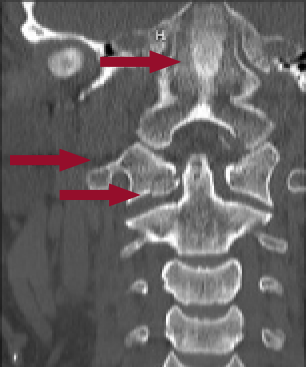
Explore This Issue
ACEP Now: Vol 41 – No 01 – January 2022Figure 1: CT showing a C1 fracture with evidence of retroclival hemorrhage extending through foramen magnum. Facets at C1–C2 are no longer aligned.
Atlanto-occipital dissociation (AOD) is often the result of high-velocity trauma injuries.1 It is believed that AOD may have a higher incidence than previously estimated due to the number of cervical spine (C-spine) injuries that resulted in death with AOD having been found on postmortem examinations.
The Case
A 30-year-old woman initially presented to a small community emergency department following a motor vehicle crash. The patient was a restrained driver in a sedan that was T-boned by a pickup truck in an intersection at high speed. The patient had a prolonged extraction, with initial Glasgow Coma Score (GCS) of 5. EMS was unable to intubate with direct laryngoscopy in the field but was able to use a bag valve mask effectively until arrival at the emergency department. C-spine precautions were maintained throughout the prehospital and hospital settings.
During the prompt primary survey, the patient was intubated due to having a GCS of 3. The patient subsequently had a one-view chest X-ray to confirm placement and was quickly transferred to the Level 1 trauma center. Upon arrival to our emergency department, the patient was assessed by an emergency medicine resident, the emergency medicine attending, and the trauma team. The patient was arousable, with a GCS of 10T. She was moving all extremities and demonstrated minimal external signs of trauma; however, she may have had mildly decreased sensation on the right side. The patient was quickly sent to CT following the primary survey, focused assessment with sonography in trauma (FAST), X-rays, and secondary survey. Despite the patient’s well appearance, her C-collar remained on and C-spine precautions were kept.
Following CT, we received an urgent call from the radiologist that the CT demonstrated a retroclival hemorrhage extending through the foramen magnum with mass effect on the medulla and upper cervical spinal cord, as well as a displaced type 3 left occipital condylar fracture and mildly displaced fracture through right anterior C1 arch (See Figure 1). The neurosurgery consult note read, “Atlanto-occipital dissociation injury—extremely unstable, skull is detached from C-spine. Typically, this injury is immediately fatal in about 80% of cases.”
Discussion
 Figure 2: MRI showing a subdural hematoma at the cervical medullary junction causing stenosis to the spinal canal just inferior to the foramen magnum
Figure 2: MRI showing a subdural hematoma at the cervical medullary junction causing stenosis to the spinal canal just inferior to the foramen magnum
Pages: 1 2 3 | Single Page



No Responses to “Serious C-Spine Injuries Are Becoming More Common—and Survivable”